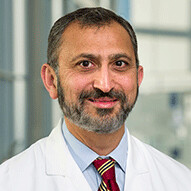Pediatric liver (hepatic) tumors
What are pediatric liver (hepatic) tumors?
Hepatic (liver) cancer is rare in children. The most common mass in younger children is hepatoblastoma. Older adolescents are more likely to be diagnosed with hepatocellular carcinoma, which more readily metastasizes (spreads to other parts of the body).
What are the different types of pediatric liver (hepatic) tumors?
Mesenchymal hamartomas (usually benign)
Hepatocellular carcinomas
How are pediatric liver (hepatic) tumors diagnosed?
Diagnosing liver cancer includes distinguishing them from other non-malignant masses such as hemangiomas, which are the most common benign liver mass.
Hemangiomas - These are most often found in infants less than 6 months old.
Mesenchymal hamartomas - These are rare benign masses usually found in children under 2 years old.
Hepatoblastoma - Although malignant, usually does not spread beyond the liver. About 90% of hepatic malignancies in children age 4 or younger are hepatoblastomas. The tumor is associated with a number of genetic conditions.
Hepatocellular carcinoma - This has a lower 5-year survival rate than that for hepatoblastoma. The carcinoma is associated with some familial syndromes and in some regions with a high incidence of Hepatitis B, which children acquire perinatally.
Other types of liver malignancies are even rarer:
Undifferentiated embryonal sarcoma of the liver, which usually occurs in children between age 5 and 10 years.
Infantile choriocarcinoma of the liver which originates in the placenta and appears in a young infant’s liver.
Epithelioid hemangioendothelioma is a rare vascular cancer.
What testing is doing to diagnose pediatric liver (hepatic) tumors?
Children with a liver malignancy usually have a painless mass or swelling in the abdomen. Some children have pain, nausea, vomiting and unexplained weight loss.
Serum tumor markers can identify elevated beta-human chorionic gonadotropic or alpha-fetoprotein levels.
Liver function tests (LFT) and blood chemistry studies can indicate liver disease.
Imaging in children usually begins with ultrasonography and may be followed by computed tomography (CT) and magnetic resonance imaging (MRI) as necessary.
A biopsy confirms diagnosis and immunohistochemistry may be used to determine genetic causes of liver tumors.
How are pediatric liver (hepatic) tumors treated?
Because liver cancers are so rare in pediatric patients and often associated with genetic syndromes, the tumors should be managed by a multidisciplinary team of pediatric specialists.
Surgery options range from removal of tumors to total hepatectomy and liver transplant.
Chemotherapy - Children also may need chemotherapy and radiation therapy, depending on the stage and type of liver tumor.
We will continue to work with patients’ families and community physicians after care to assist you with follow-up and surveillance for recurrence or a second cancer.
Why Children's Health?
Children’s Health is staffed by expert and experienced specialists who are faculty at UT Southwestern Medical Center. The Pauline Allen Gill Center for Cancer and Blood Disorders is a world-class and nationally recognized leader in pediatric cancer research. Our pediatric oncologists, pediatric surgeons and other specialists can manage these rare tumors.
Pediatric liver (hepatic) tumors doctors and providers
 Adam Alder, MDPediatric Surgeon
Adam Alder, MDPediatric Surgeon Amal Aqul, MDPediatric Hepatologist
Amal Aqul, MDPediatric Hepatologist Natasha Corbitt, MDPediatric Surgeon
Natasha Corbitt, MDPediatric Surgeon Diana Diesen, MDPediatric Surgeon
Diana Diesen, MDPediatric Surgeon Lauren Gillory, MDPediatric Surgeon
Lauren Gillory, MDPediatric Surgeon Stephen Megison, MDPediatric Surgeon
Stephen Megison, MDPediatric Surgeon Megha Mehta, MDPediatric Gastroenterologist
Megha Mehta, MDPediatric Gastroenterologist Joseph Murphy, MDPediatric Surgeon
Joseph Murphy, MDPediatric Surgeon Samir Pandya, MDPediatric Surgeon
Samir Pandya, MDPediatric Surgeon Faisal Qureshi, MDPediatric Surgeon
Faisal Qureshi, MDPediatric Surgeon Charina Ramirez, MDPediatric Gastroenterologist
Charina Ramirez, MDPediatric Gastroenterologist Norberto Rodriguez-Baez, MDPediatric Hepatologist
Norberto Rodriguez-Baez, MDPediatric Hepatologist Isabel Rojas Santamaria, MDPediatric Gastroenterologist
Isabel Rojas Santamaria, MDPediatric Gastroenterologist Mark Ryan, MDPediatric Surgeon
Mark Ryan, MDPediatric Surgeon To Nhu Nguyen, PA-CPhysician Assistant - Gastroenterology
To Nhu Nguyen, PA-CPhysician Assistant - Gastroenterology